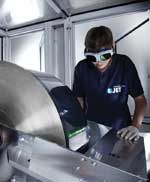Europe’s photovoltaic (PV) market is facing challenges including cuts in government subsidies and incentives, and those challenges affect laser makers who supply PV fabricators with equipment. But the outlook isn’t as cloudy as it could be. For one thing, approximately two-thirds of the new solar panels installed around the world in 2011 were put up on European soil, according to a recent report from the European Commission’s Joint Research Center. Clearly, the market for solar won’t disappear anytime soon.

4JET Technologies GmbH supplies laser equipment for materials processing
in the thin-film industry, including, as seen here, laser patterning of
third-generation flexible solar cells.
To get an inside look at the situation, Photonics Spectra recently spoke with representatives of two European companies that make laser equipment for PV manufacturing: Alejandro Becker, director of sales at InnoLas Systems in Krailing, Germany, and Jörg Jetter, founder and CEO of 4JET Technologies GmbH in Alsdorf, Germany.
Q: How would you say the market has been in the past few years for PV manufacturing lasers?
Jetter: After a small dip in 2009, there has been a tremendous investment boom in 2010 that ended [in] early 2011. Since then, new business is relatively flat, and we expect the next two years to see little in terms of capacity increases.
However, we do expect to sell further equipment aiming at development of new cell concepts, such as flexible and/or organic PV and line enhancement projects, to [a] few select players as well as new CIGS [copper indium gallium selenide] projects.
Becker: The current market conditions start to separate the men from the boys. PV manufacturers have become more demanding to get robust solutions that work 24/7/365.
I think this is a healthy development and only normal for a maturing market.
Q: Where do you think the market is going?
Becker: The recent past has seen a market consolidation, but medium-term, there is only one way: up. Major economies like Germany and Japan are moving away from fossil fuels and nuclear power, and that means investments in renewable energies like PV.
Also, we are not only talking about new PV fabs. We are seeing a significant demand for retrofitting existing production lines with advanced laser systems to increase cell efficiency and productivity.
Jetter: We serve another very traditional industry: tire manufacturing. For us, this is an example of a mature and consolidated industry with the top five players sharing approximately 70 percent of the market and basically only one dominant technology to produce an almost commoditized product.
Ultimately, solar will be not much different, though it will certainly take a decade until this is sorted out. Until then, the race is open – and even if it seems unlikely now, we could still [see] the dominance of crystalline silicon [diminish] somewhat.
Q: What do you see as the “next big thing” in laser-based PV manufacturing in general?
Becker: In a nutshell, efficiency and productivity. End users have understood the importance of high efficiency, so this has become a major selling point for cell manufacturers.
Likewise, the market is price sensitive, and this means that productivity must be increased to reduce manufacturing costs and cost of ownership. Our ILS TT laser system for contact opening is a good example for this: It allows [users] to improve the efficiency of standard monocrystalline cells by up to 1 percent with a throughput of 3400 wafers per hour. This has made it a very popular solution in the market.
Jetter: We expect that third-generation thin-film concepts on flexible substrates have great long-term potential.
Q: Are you seeing any new and exciting advances coming out of R&D and/or university labs?
Jetter: We see significant progress both in organic PV, as well as steady efficiency increases in the CIGS, CdTe and also a-Si community.
Becker: We are cooperating closely with a number of the leading research labs in this market and also do extensive R&D in our own laboratory. There are a couple of promising new technologies that we evaluate, but it is our philosophy to introduce new concepts only when they are production-ready.
The manufacturers do not need spectacular lab results but systems that work reliably in industrial production lines.
Q: What are the biggest challenges to new advances in lasers for PV manufacturing?
Jetter: The economical difficulties of the target market.
Becker: The biggest challenge is to develop systems that are tailored to a specific customer’s need. It is a question of fine-tuning all components and parameters to perfectly match the manufacturing environment.
Many customers are positively surprised when they see the optimized results our application engineers achieve.
Q: And which application areas would you say are thriving – and why?
Becker: We see a big demand for laser systems catering [to] the PERC (passivated emitter and rear cell) technology to significantly [increase] the efficiency of crystalline cells, while at the same time enabling a higher throughput with a minimum of additional footprint needed.
As I said earlier, cell efficiency and productivity are crucial for cell manufacturers, and these investments pay off in a very short time.